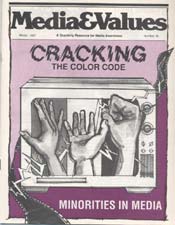GLOBAL: World's Airwaves Echo Racist Attitudes
|
This article originally appeared in Issue# 38
|
Minorities are still invisible on British television — in fact, you could watch for days at a time without seeing a black or brown face. A little research into the attitudes of programmers and advertisers helps to explain why.
Salman Rushdie, author of Midnight's Children, tells the story of a British advertiser rejecting an ad jingle because the singer sounded as if he had a "black voice." In another incident, the head of a leading confectionary firm refused to cast a black child as one of a group in an ad for his firm's product.
But advertising people aren't the only racists around. Rushdie also recounts the case of an editor of a television series on Africa who refused to feature a black historian on the programs. A white British historian made them instead, and the series was widely applauded.
Even radio and television programs targeted at black and Asian Britishers (a description, by the way, that the media would never use) are insensitive to nuances of language and pronunciation. In-than musical programs mispronounce names and film titles. The world-renowned Fleet Street press regularly misspells the name of Gandhi.
Misrepresentation of minorities is routine in a country that tries to ignore its large urban population of immigrants from India and the West Indies. Members of such populations who do make a brief media appearance are not infrequently presented as a 'problem.' Only if you watch minority-produced programming in off-prime hours do you get some feeling of what it means to be black or brown in Britain.
Ethnic minorities fare no better on other European television networks. Algerians, Tunisians and Cameroonians in France and the Turkish in Germany are victimized in a similar manner.
Although this discrimination is racial, we might compare it to the situation of the poor and underprivileged in the media of non-white countries. In India, for example, news values similar to those of the West prevail. Thus, the rich and the mighty are ever in the news, while the plight of tribes and lower castes striving to eke out an existence is rarely highlighted. Only a major riot or local catastrophe brings them to public notice. Indian cinema, the largest in the world, is biased in favor of the country's northern culture. Minorities such as Christians are often presented as drunkards and women as easily available.
It is clear that throughout the world minority groups need to become more active in presenting their own interests, and those of the downtrodden and the voiceless. The history of media portrayals shows that protests can play a major role in including minority images in media and highlighting minorities' active presence in society. Only then can modem technology and the new opportunities presented by satellites and cable television be used to present a balanced picture of the pluralism and multiracial nature of most modem societies.



